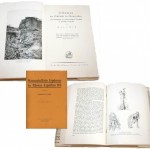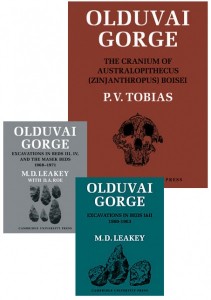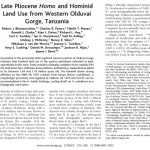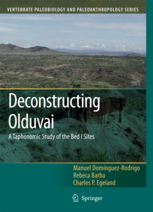History of Olduvai
The Research History
Olduvai Gorge is one of the richest paleoanthropological sites in the world, documenting the evolution of our lineage and its environmental contexts over the last 2 million years (Ma). Discoveries include two hominid holotypes, Australopithecus boisei (Leakey 1959) and Homo habilis (Leakey 1960, 1961, Leakey, Tobias & Napier 1964) as well as remains of H. erectus (e.g., L.S.B. Leakey 1961). There are abundant stone artifacts, evidence of human technology as it evolved from the Oldowan Industrial Complex to the Acheulean, Middle Stone Age, and Later Stone Age (M.D. Leakey 1971; M.D. Leakey & Roe 1994; Mehlman 1977, 1989). Olduvai also consistently yields rich fossil evidence of vertebrate communities (e.g., Leakey 1951, 1965, 19971).
Since its discovery in 1911 (Reck 1933), Olduvai has been the focus of several long-term research projects. The most famous of these was the Leakeys’ that operated from 1931 to 1983.
The early Olduvai expeditions yielded abundant stone artifacts as well as animal and plant fossils. Well over 25 new taxa have been named based on fossils from Olduvai, making it an important site for Neogene paleontology.
The richest horizons are Beds I-II with over 100 vertebrate taxa represented (L.S.B. Leakey 1965). At least 37 vertebrate taxa are known from Bed III, 62 from Bed IV, and 23 from the Masek Beds (Leakey & Roe 1994). The complementary geological work by Hay (1976, 1990) established an extensive understanding of the paleogeography and stratigraphic sequence throughout the gorge.
The Institute of Human Origins (IHO) followed (1985-1988), expanding the hominid fossil record with OH 62, skeletal remains of H. habilis published in the journal Nature in 1987 by Dr. Johanson and his colleagues.
Other projects ranging from archaeology, paleontology, and geology have utilized the extensive Olduvai sequence and fossil assemblages, including Tobias (1967, 1991), Gentry (1966, 1978), Susman & Stern (1982), Rightmire (1983, 1993), Potts (1988), Kafumu 1996, Fernandez-Jalvo et al. (1998), Aiello et al. (1999), Marzke & Marzke (2000), Kimura (2002), de la Torre & Mora (2005), McHenry (2011), McHenry et al. (2008), Mollel et al. (2011), Njau (2006), Dominguez-Rodrigo et al. (2007), Pante et al. 2011, etc.
The longest-running of the current projects is the Olduvai Landscape Paleoanthropology Project (OLAPP), initiated in 1989 and co-directed by Drs. Fidelis Masao, Rob Blumenschine (Blumenschine & Masao 1991), and since 2006 with Dr. Jackson Njau. OLAPP studies the environmental contexts of paleoanthropological occurrences across synchronic landscapes. This approach targets single horizons traced and periodically excavated across the gorge. OLAPP has established a broad-scale habitat structure for four Oldowan hominid landscapes: 1) Lower Bed I; 2) Middle Bed I; 3) Upper Bed I, and 4) Lowermost Bed II (Blumenschine et al., 2003; 2008, 2011a, 2011b; Blumenschine & Peters 1998; Ashley & Hay 2002, Albert & Bamford 2006, 2009, 2011; Bamford 2011, Stollhofen et al. 2008, Njau & Blumenschine 2011, Peters & Blumenschine 1995).
The OLAPP sampling effort has yielded >20,000 stone artifacts, >25,000 vertebrate specimens (including all fragments from excavation), and dozens of macroplant fossils (See: special issue of Journal of Human Evolution 2012 vol. 63 no. 2). More than nine new hominid individuals belonging to A. boisei, H. habilis and gracile Australopithecine species have also been recovered (e.g., Blumenschine et al. 2003, Clarke 2012). All paleoanthropological material including hominids collected since 1989 have been studied and securely curated at the National Natural History Museum in Arusha, Tanzania, http://olduvai-paleo.org/education/.
A new project focusing on the geology and Archaeology of Bed II was established in 2006. Co-directed by OLAPP’s former graduates (Drs. Lindsay McHenry and Jackson Njau) and Dr. Ignacio de la Torre, this project (Olduvai Geochronology & Archaeology Project – OGAP) http://www.olduvai-gorge.org/index.html seeks to understand the biological and ecological basis for technological transition between Bed I and Bed II
Dr. Manuel Domínguez-Rodrigo and colleagues (TOPP, e.g., 2007, 2009) have focused on reinterpreting previous taphonomic work. Their research has demonstrated evidence of anthropogenic activity described by the Leakeys (1960, 1971) in the sediments older than 1 Ma, and demonstrated hominid exploitation of small and middle-sized animals in Upper Bed II at the BK site.
OVPP is a new project operating financially and officially separate from these other ongoing projects, although OVPP, OLAPP & OGAP share a common co-director who will facilitate communication and coordination (J.K. Njau). We are distinct in our focus on paleontology and our broader collection strategy (not just excavation).
Given the extreme richness of this site, the presence of multiple research teams has been argued to be essential for maximizing its scientific output (Domínguez-Rodrigo, Mabulla & Bunn, 2007).



